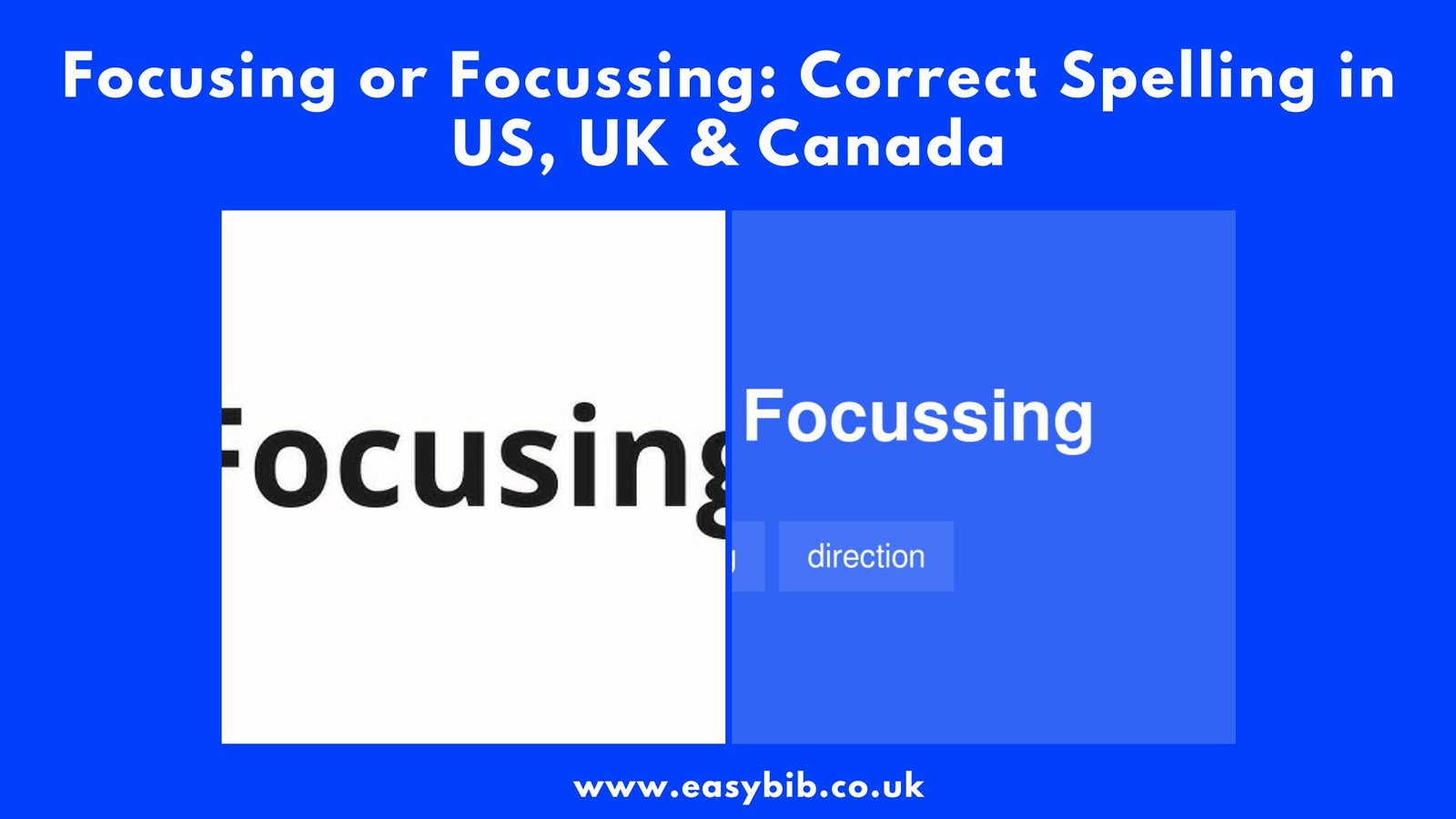Focusing or Focussing: Correct Spelling in US, UK & Canada

English spelling has always been a source of debate and variation. A single word can appear in two or more spellings, yet both may be considered correct depending on context and region. One of the most common examples is the difference between focusing and focussing.
At first glance, this may appear to be a simple typo, but in reality it reflects deeper rules of English spelling and historical preferences across dialects. To understand this difference, we must explore the origins of the word, the spelling rules that guide it, and the regional practices that shape its use.
The Origin and Meaning of “Focus”
The word focus has an interesting history. It was borrowed from Latin in the 17th century. In Latin, focus meant “hearth” or “fireplace,” a place where warmth and light gathered. Later, scientists adopted the term in the field of optics to describe the point where rays of light meet.
From there, the meaning broadened to cover central points of attention or activity. Today, the word is used both literally and figuratively. In daily English, focus commonly refers to concentration, clarity, or the act of paying attention.
When verbs in English change form, they often take suffixes such as -ed or -ing. This process sometimes triggers changes to the base word. For focus, the question is whether the final s should be doubled when forming focused/focussed or focusing/focussing.
Spelling Rules Behind the Variation
English has a fairly consistent rule about doubling final consonants when adding suffixes. If a one-syllable word ends in a single consonant preceded by a single vowel, and the stress falls on that final syllable, the consonant is doubled. For example, run becomes running and begin becomes beginning. Doubling helps preserve the short vowel sound in the base word.
Why “Focus” Is an Exception
The word focus does not meet all the conditions for doubling. It ends with the consonant s, and it has more than one syllable. More importantly, the stress falls on the first syllable: FO-cus. Because of this, most spelling guides do not require doubling the s. As a result, focused and focusing are considered standard and are listed as the main forms in dictionaries.
However, English also allows flexibility. Some traditions apply doubling even when stress is not final, especially in British English. This is why focussed and focussing remain in circulation. They are not wrong, but they are less common.
Usage in American English
In American English, spelling tends to simplify forms whenever possible. The dominant spellings are focused and focusing. These are the only versions listed in most American dictionaries, such as Merriam-Webster. Americans rarely use focussed or focussing, and when they do appear, they are often considered mistakes.
For professional, academic, or journalistic writing in the United States, focused and focusing are the safe choices. They are universally recognized, and using the double-s forms would likely distract readers or even reduce credibility.
Usage in British English
British English is more flexible with spelling. Both focused and focussed appear in British publications. The same is true for focusing and focussing. Historically, the double-s forms were more common in the UK. Older books, government documents, and academic papers often used focussed and focussing.
However, language evolves, and modern British writing increasingly favors the single-s forms. Today, newspapers like The Guardian or The Times often prefer focused and focusing. Despite this shift, British readers are still familiar with the double-s spellings, and they do not regard them as incorrect. Writers in the UK can choose either form, but they should remain consistent within a single piece of writing.
READ MORE
Usage in Canadian English
Canadian English blends elements from both British and American traditions. In many cases, Canadians accept both styles, though one may be more dominant. For focus, the single-s spellings (focused and focusing) are far more common in Canada. Canadian dictionaries and government standards typically align with American practice on this word.
That said, Canadians are also exposed to British usage, especially through literature and academic publishing. As a result, some Canadians may use focussed or focussing without feeling they are wrong. Still, in professional or formal contexts, focused and focusing remain the best choice in Canada.
Usage in Australian English
Australian English tends to follow British spelling conventions. For that reason, both forms are considered acceptable in Australia. Australian writers and editors may encounter both focusing and focussing in print, as well as focused and focussed.
In practice, however, many Australian publications lean toward the single-s versions. The rise of international digital publishing has reinforced this preference, as focused and focusing are easier to standardize across global audiences. Nonetheless, Australian readers would not be surprised by the double-s forms, and they remain valid.
Practical Guidance for Writers

The safest strategy is to match your spelling to your intended audience. If you are writing for Americans or Canadians, use focused and focusing. If you are writing for a UK or Australian audience, you can use either form, though the single-s spellings are increasingly favored.
Whichever form you choose, use it consistently. Switching between focusing and focussing in the same document looks careless and may confuse readers. Consistency is often more important than which form you pick.
When writing for professional or academic contexts, always check the relevant style guide. Guides such as APA, MLA, or Chicago in the US demand focused and focusing. British publishers may accept both, but many have internal rules that favor the single-s spellings.
Examples in Use
- The manager is focusing on long-term growth.
- She focused her energy on completing the project.
- The researcher remained focussed on the data analysis.
- They are focussing on building stronger relationships.
In these sentences, the first two examples reflect American and international standard spelling. The last two are accepted in the UK and Australia but would look unusual in North America.
READ MORE
Conclusion
The question of focusing versus focussing highlights how English spelling rules can vary across regions. The single-s spellings (focused and focusing) dominate in American, Canadian, and increasingly in British and Australian English. The double-s versions (focussed and focussing) are still correct, especially in the UK and Australia, but they are less common today.
For most writers, the simplest and safest choice is focused and focusing. These spellings are accepted everywhere and are unlikely to cause confusion. However, the double-s spellings remain part of English tradition, and readers in certain regions still encounter them.
The key for writers is not just to choose the correct form, but to use it consistently. By doing so, they show respect for language norms, clarity for their readers, and professionalism in their communication.
